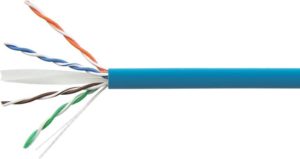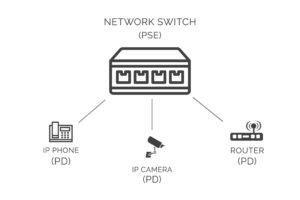There is an increase in Power over Ethernet products emerging into the market. Power over Ethernet is a technology that allows network cables to carry energy alongside of data. Power over Ethernet, or PoE, is useful for devices such as IP cameras, wireless access points, network routers, and access control points along with many other devices.
Imagine having to install an IP camera outside of your home. Placing a camera with a network cable is easy enough; however, getting power to an area without any sockets can be daunting. Power over Ethernet eliminates this problem by allowing you to draw electrical currents through the Ethernet cable. In this blog we will discuss what is Power over Ethernet, how it works, and why it is beneficial.
How Does it Work?
Just as the name suggests Power over Ethernet is a technology that allows a device to be powered with a network cable. These network cables are often Cat 5e or Cat 6 Ethernet cables. Inside these cables are eight wires that are arranged as four twisted pairs. Two of these pairs are used for sending data, while the other two pairs are unused and are called spare pairs. The electrical current goes through the Ethernet cord using each pair as a single conductor. Then it can use either of the other two data pairs or two spare pairs to carry the electrical current. Power over Ethernet goes through the cable at a voltage around 44 and 57 DC.
Devices and Sourcing Equipment
Two devices are involved when using Power over Ethernet, power sourcing equipment (PSE) and powered devices (PD). Powered devices are PoE enabled network end devices that accept a low voltage transmission over structured Ethernet cabling. Power sourcing equipment provides the DC amps to the powered devices. PSE can be either an endspand device or a midspan device.
An endspan device, also known as an endpoint, is typically a network switch. There is no need for any other power source.
A midspan device is placed “in the middle” between a power source and PoE device that adds power to a non-PoE network switch. A midspan device is also known as a PoE injector.
What are the Advantages?
There are many advantages to using Power over Ethernet. From installation flexibility to cost benefits, PoE is a great way to install network devices. You will not need an electrician to install a new outlet nor will you have to purchase any extra cables. Using PoE technology will save you time and money. Without the need for electrical outlets you have flexibility to install a PoE device nearly anywhere you would like. Without extra cords and cables there is less clutter while minimizing points of failure.
Are There Limits?
Power over Ethernet can transmit to 100 meters. The limitation is due to Ethernet cabling standards that limit the length of an Ethernet cable to 100 meters. To lengthen the span you can use a PoE Ethernet Extender than can increase the span up to 4,000 feet. Some PoE extenders can be used outdoors, but not all. Only some extenders support gigabit speeds.
Some devices are not compliant with PoE. Devices that do not work with PoE can still be used with a PoE injector or splitter. You can mix PoE and non PoE devices on the same network, even if you have to use an injector or splitter.
Conclusion
PoE is an emerging technology that is useful and beneficial by limiting clutter and allowing energy to an area that may not be accessible otherwise. Advanced Integrated Controls uses PoE technology to benefit our clients needs. If you are interested in using Power over Ethernet for your home or office contact us today.





